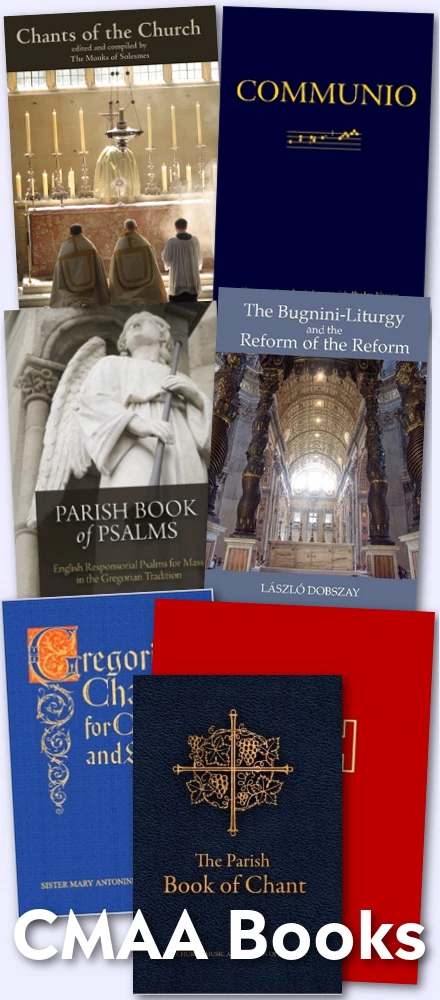This post will provide ongoing coverage of the Papal Mass which will be begin later this morning (10 am ET) at the Nationals Park in Washington, DC.
I would like to repeat Shawn's call for expectation management, especially since from what we have heard so far, and in comparison to yesterday's outstanding Vespers liturgy, at today's Mass there are bound to be elements which, for reasons extensively discussed in the last weeks, may seem disappointing from a reform-of-the-reform perspective. The NLM, however, will as always focus on those elements which can be understood as helping push forward one or another aspect of Benedict's programme for liturgical reform in continuity. I would encourage commenters to do likewise, but in any case, and as ever, to "criticize principles, not people; be discriminating, not nitpicking; be academic, not acerbic; be principled, not polemical". Also, this is the post for today's papal Mass; if you want to comment on yesterday's Vespers, there is ample opportunity to do so at this, this or this post.
In the meantime, I have posted some more pictures of yesterday's Vespers, including the allocution to the bishops given afterwards, below.
First pictures:
We have the "Benedictine" altar arrangement and the 7th candle:

The corpus of the crucifix today is turned towards the celebrant, as we expected:
Massgoers arriving:
Spiritual preparation:
Concelebrant bishops:

It begins - entrance procession (note that Msgr. Gänswein, in the back, is concelebrating):




Veneration of the altar:





The Holy Father praying the collect:
Overview:

The deacon after receiving the blessing before the Gospel:
The Pontiff listening to the Gospel:

The pope giving his sermon:
The sanctuary:


The offertory - I think there was a flat asterisk upon the paten:

Preface:

Elevation of the Sacred Species:

Final blessing:
Thursday, April 17, 2008
Papal Mass, Nationals Park, Washington
Gregor KollmorgenMore recent articles:
Recommended Art History and Artistic Practice Text Books for Homeschoolers... and Everyone Else Too!David Clayton
I want to recommend the Catholic Heritage Currricula texts books to all who are looking for materials for courses in art history, art theory and artistic practice at the middle-school or high-school level. These books present a curriculum that combines art history, art theory, and a theory of culture in a Catholic way. Furthermore, they provide the...
Launching “Theological Classics”: Newman on the Virgin Mary, St Vincent on Novelty & Heresy, Guardini on Sacred SignsPeter Kwasniewski
At a time of turmoil, nothing could be better or more important than rooting ourselves more deeply in the Catholic tradition. One of my favorite quotations is by St. Prosper of Aquitaine (390-455), writing in his own age of chaos: “Even if the wounds of this shattered world enmesh you, and the sea in turmoil bears you along in but one surviving shi...
Low Sunday 2025Gregory DiPippo
With his inquisitive right hand, Thomas searched out Thy life-bestowing side, O Christ God; for when Thou didst enter while the doors were shut, he cried out to Thee with the rest of the Apostles: Thou art my Lord and my God. (The Kontakion of St Thomas Sunday at Matins in the Byzantine Rite.)Who preserved the disciple’s hand unburnt when he drew n...
The Easter Sequence Laudes SalvatoriGregory DiPippo
The traditional sequence for Easter, Victimae Paschali laudes, is rightly regarded as one of the greatest gems of medieval liturgical poetry, such that it was even accepted by the Missal of the Roman Curia, which had only four sequences, a tradition which passed into the Missal of St Pius V. But of course, sequences as a liturgical genre were extre...
The Paschal Stichera of the Byzantine Rite in EnglishGregory DiPippo
One of the most magnificent features of the Byzantine Rite is a group of hymns known as the Paschal stichera. These are sung at Orthros and Vespers each day of Bright Week, as the Easter octave is called, and thenceforth on the Sundays of the Easter season, and on the Leave-taking of Easter, the day before the Ascension. As with all things Byzantin...
Medieval Vespers of EasterGregory DiPippo
In the Breviary of St Pius V, Vespers of Easter Sunday and the days within the octave present only one peculiarity, namely, that the Chapter and Hymn are replaced by the words of Psalm 117, “Haec dies quam fecit Dominus; exsultemus et laetemur in ea. – This is the day that the Lord has made; let us be glad and rejoice therein.” In the Office, this...
Summer Graduate-Level Sacred Music Study - Tuition-freeJennifer Donelson-Nowicka
The May 1st application deadline is approaching for summer graduate courses in sacred music at the Catholic Institute of Sacred Music. Graduate-level study structured for busy schedulesIn-person, intensive course formatsAffordable room & boardFree tuitionLearn more and apply here.Courses:Choral InstituteComposition SeminarOrgan ImprovisationIn...
The Last Service of EasterGregory DiPippo
Following up on Monday’s post about the service known as the Paschal Hour in Byzantine Rite, here is the text of another special rite, which is done after Vespers on Easter day itself. It is brief enough to show the whole of it with just one photograph from the Pentecostarion, the service book which contains all the proper texts of the Easter seaso...
Should Communion Sometimes Be Eliminated to Avoid Sacrilege?Peter Kwasniewski
In a post at his Substack entitled “Nobody is talking about this in the Catholic world,” Patrick Giroux has the courage and good sense to raise the issue of the indiscriminate reception of the Lord at weddings and funerals where many attendees are not Catholics, or, if Catholics, not practicing, not in accord with Church teaching, or not in a state...
Update on the Palestrina500 Festival in Grand RapidsPeter Kwasniewski
On Friday, February 14th, the feast of Saint Valentine, Sacred Heart of Jesus Parish in Grand Rapids, MI welcomed Gesualdo Six from London to sing a choral meditation and Mass for the parish's yearlong Palestrina500 festival.The choral meditation consisted of:Palestrina: Litaniae de Beata Virgine Maria a6Antoine Brumel: Sub tuum praesidiumJosquin d...




















